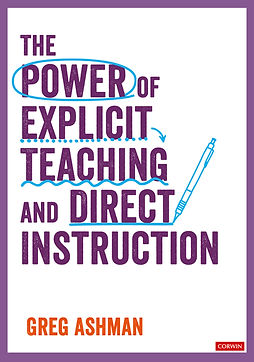Explainer: What’s the difference between decodable and predictable books & when should they be used?
Explainer: What’s the difference between decodable and predictable books & when should they be used?

Earlier this year, Greg Ashman released his second book, The Power of Explicit Teaching and Direct Instruction. Those who are familiar with Ashman’s blog, ‘Filling the Pail’, will recognise the no-nonsense frankness with which the author writes. Mostly, he deals with topics using facts and research evidence, though there’s a sizeable pinch of sass thrown in, too.
By Nicola Bell
Ashman addresses a few key questions in the book, the two main ones being what should we teach, and how should we teach it? The what question relates largely to whether it is worth teaching subject-specific content knowledge, or whether more generic skills, such as critical thinking or problem-solving, might better prepare students for life beyond school.
Ashman sits staunchly in the knowledge corner, and with good reason. From an empirical perspective, there is very little research evidence to support the long-term teaching of “thinking skills”, like memory. From a psycho-philosophical perspective too, Ashman argues that it’s hard to conceptualise a separation between thinking and knowledge. As he says in the first chapter (p. 12),
Rather than seeing the mind as a set of library shelves and knowledge as the neatly ordered books that fill those shelves, perhaps we should see the mind as a set of tools made out of knowledge. Knowledge is what you think with. Knowledge is the mind.
So then, it would seem reasonable to decide that teaching content-specific knowledge is the way to go. But what knowledge are we talking about, here? Or rather, whose? After all, the shared knowledge we’ve accumulated in areas of literature, art and science, both in Australia and in other Western countries, is dominated by “an overabundance of dead white men” (p. 14).
This is a very big question – bigger than what any individual teacher should need to grapple with. For that reason, Ashman doesn’t offer a straightforward solution. (Also, there isn’t one.)
He does, however, suggest that knowledge and works of art that have endured are worthy of teaching. As has been stated elsewhere, this accumulation of enduring cultural knowledge is evolving to become ever more inclusive. And it should continue to do so, just as long as society does the same.
Having discussed the what, Ashman then moves on to the how. Specifically, he focuses on explicit teaching and direct instruction – unsurprising, given the book’s title. As well as comprehensively describing the history of research that has been conducted to support the principles of explicit instruction, Ashman justifies these findings with reference to cognitive learning models. These links between observable student achievement and invisible student cognition are very valuable, and they are made even more poignant when contextualised by snippets of Ashman’s own experiences in the classroom.
As a young science teacher, I remember being amazed by a more experienced colleague who would teach science practical skills in [a step-by-step] way. She would say things like ‘I want you to pick up your test tube and place it in a rack and then put that in front of you to your right. Let’s see. Josh – that’s your left. Good. Now, I want you to pick up the spatula.’ It blew my mind because I was asking my own students to conduct entire investigations in an atmosphere bordering on chaos. What’s more, her students looked as if they were enjoying themselves, whereas mine seemed distracted. (p. 124)
Ashman draws specific connections between explicit teaching and cognitive load theory – the latter being the subject of his ongoing PhD research. Beyond that, he also outlines how knowledge of the theory can be exploited and embedded into effective teaching practice.
Throughout the book, Ashman’s arguments are clearest when the what and how questions are kept separate – in other words, when knowledge-based instruction is contrasted with skills-based instruction, or when explicit teaching is contrasted with an enquiry approach. He does sometimes blur the lines, and it was in those sections of the book that I got a little lost. That said, and as Ashman acknowledges early on, those who favour a knowledge-based curriculum tend also to favour an explicit or direct method of teaching. So, some conflation between instructional content and instructional method was perhaps inevitable. Regrettably, things in real life are just not as clear-cut as I would like them to be.
The book also contains a chapter on differentiation, which, while not directly linked to explicit instruction, has obvious implications for classroom teachers. Ashman’s perspective is that our understanding of differentiation – that is, “treating children differently, depending on their needs” (p. 64) – is misapplied in practice, and may be a mechanism for increasing inequality. This is a fair point: if students are given tasks that only align with their background, interests or ability level, they miss out on exposure to a lot of other challenging and valuable content. I am therefore persuaded of the need to narrow or more clearly define what ‘differentiation’ means, though I am not as convinced as Ashman that the term needs scrapping altogether.
In all, The Power of Explicit Teaching and Direct Instruction will be a useful addition to my reference bookshelf. Ashman writes well, and he effectively weaves together elements of the empirical, the practical, and the philosophical. For me, the book’s greatest strength was its contextualisation of instructional techniques within a cognitive science framework (see the excerpt below, for an example).

When it comes to academic pursuits, it is critical to ask: what are these hidden subcomponents that need to be developed in order to deliver a relatively expert performance? Take, for example, a question on the 2018 VCE English examination sat by 18-year-olds in Victoria, Australia. Having read the play Medea by Euripides, they were asked to write an essay on the topic, “‘Disloyalty is the greatest crime in this play.’ Discuss.”
First, they must be able to read. They must have the background knowledge to understand what they read and understand class discussions. They must read Medea and learn key facts and concepts related to it. They must also be able to write an essay. This will require them first to be able to form letters, write words and then write sentences. They will need to be able to structure these sentences into coherent paragraphs which they are then able to weave into a coherent essay. Perhaps more mundanely, they must be able to finish writing the essay in the time given, which will require a great deal of experience of writing.
Writing is perhaps an example of an area that we often attempt to teach in a top-down fashion. Primary school students write stories or recounts of what they did at the weekend. Standardised assessments require students to write coherent arguments, so students write these over and over again, and the teacher provides ‘feedback’ in the form of a written comment at the end of each piece. Such feedback cannot hope to be corrective to all the possible spelling errors, run-on sentences, misunderstandings of content, unsophisticated vocabulary use and so on that may be present in an extended piece of writing, so teachers often focus on just one or two points. We are saying to students, ‘Do this complex task badly and then we will point out a couple of the ways in which you did it badly’.
It is as if a football coach eschewed all drills and exercises, and insisted on coaching football players by requiring them to play entire games of football, remaining silent as they do so and then, at the end of each game, giving each player a couple of handwritten sentences on how to improve for next time: ‘What went well is that your passing was largely accurate. You should work on your tackling and your position on the park.’ (pp. 57-58)
Nicola Bell (@NicolaBellSP on Twitter) works in the MultiLit Research Unit as a postdoctoral research fellow. She has a PhD from the University of Queensland on the topic of literacy development in children with cochlear implants, and her research interests extend to language and literacy development in all school-aged children.
This article appeared in the June 2021 edition of Nomanis.
Explainer: What’s the difference between decodable and predictable books & when should they be used?